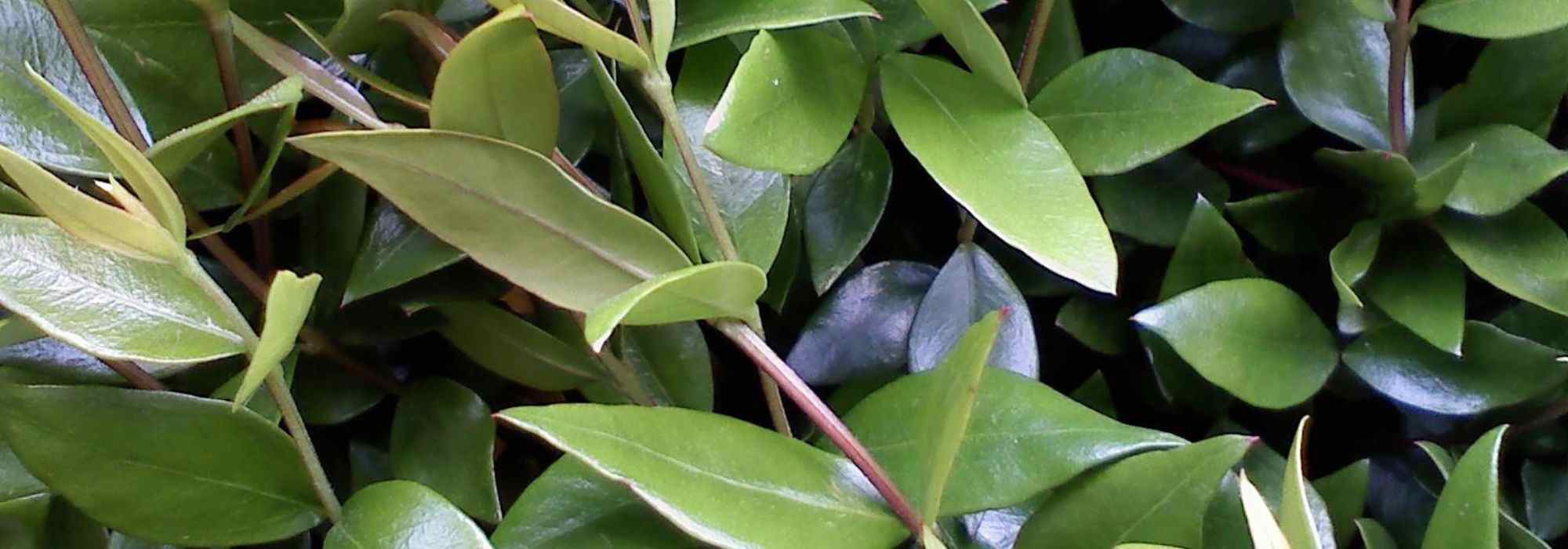
9 bushes for dry soil
Successfully creating a resilient hedge with shrubs that are both beautiful and easy to care for.
Contents
Among the plants suited to dry soils, many bush varieties for hedges with evergreen and colourful foliage allow for the creation of all sorts of screens, either trimmed or left to grow naturally, where the soil remains dry. Whether tall, dense, or not, these hedge bushes can adapt to living conditions that deter many other plants. Sometimes valued for their decorative foliage, which can be solid or variegated, some make their colourful and fragrant flowering a true asset for creating beautiful green hedges, especially in sunny spots. In this selection, discover 9 hedge bushes that will make you forget your dry soil.
To avoid any mistakes and ensure suitable planting, we recommend adopting our web application Plantfit.
Myrtle - Myrtus communis 'Tarentina'
With small, leathery, glossy dark green leaves, the Tarentine myrtle, Myrtus communis ‘Tarentina’ blooms in the height of summer generously from July to September.
On its dense, dark mass, a multitude of small white flowers with prominent, fragrant stamens burst forth like snowflakes.
Relatively hardy in well-drained soil and not demanding regarding soil type, this variety is essential in a dry garden, thriving in both sun and shade. The evergreen, highly aromatic leaves are glossy on both sides and resemble boxwood.
Its drought resistance, slow growth, and tolerance to repeated pruning make it a perfect candidate for forming hedges, decorating a terrace, or flowering the undergrowth of a pine forest.
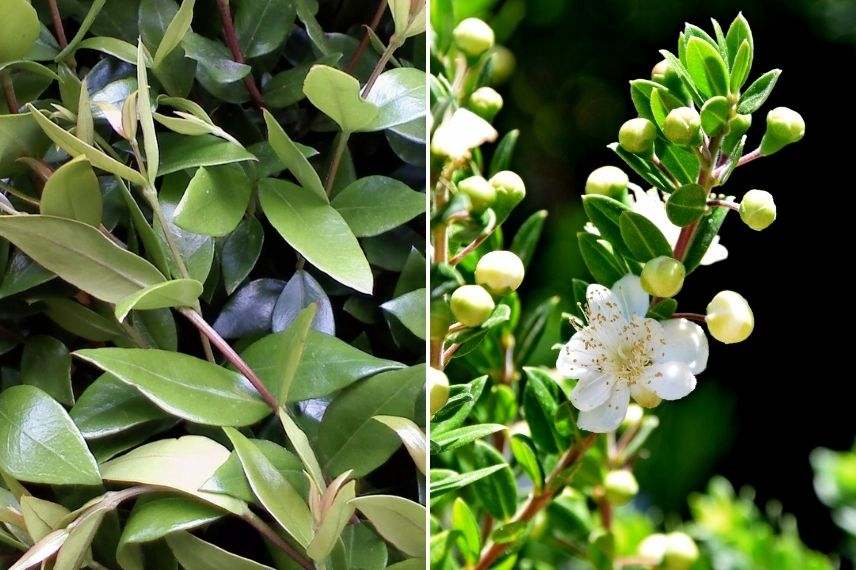 The ‘Tarentina’ myrtle withstands summer drought and decorates the summer with its white flowers and fruits even in calcareous soil.
The ‘Tarentina’ myrtle withstands summer drought and decorates the summer with its white flowers and fruits even in calcareous soil.
Read also
7 shrubs for a South-facing gardenMastic tree or pistachio - Pistacia lentiscus
Easy to grow, the Pistacia lentiscus only fears cold winters, especially when young, while a well-established specimen, aged 4 or 5 years, will be able to withstand brief frosts of around -12 to -15°C.
It is a deciduous bush with small, glossy, tight leaflets that makes a remarkable groundcover. It quickly forms a substantial clump or a hedge up to 2 m tall. It retains its beautiful aromatic dark green foliage even during prolonged dry periods. As it is not afraid of sea spray, it can be adopted without hesitation by the seaside. Like the laurustinus, strawberry trees, myrtles, and Pittosporum, it is perfect for providing the evergreen structure of the garden.
In a free-form hedge, it can also be combined with smoke trees and deciduous spindle trees with stunning autumn colours. Its dark foliage creates interesting contrasts with shrubs that have grey leaves. Highly fruitful, it is covered in bright red, surprising, and decorative berries. Finally, it often bears colourful growths known as galls; these are caused by two parasitic organisms. These galls do not jeopardise the health of the plant.
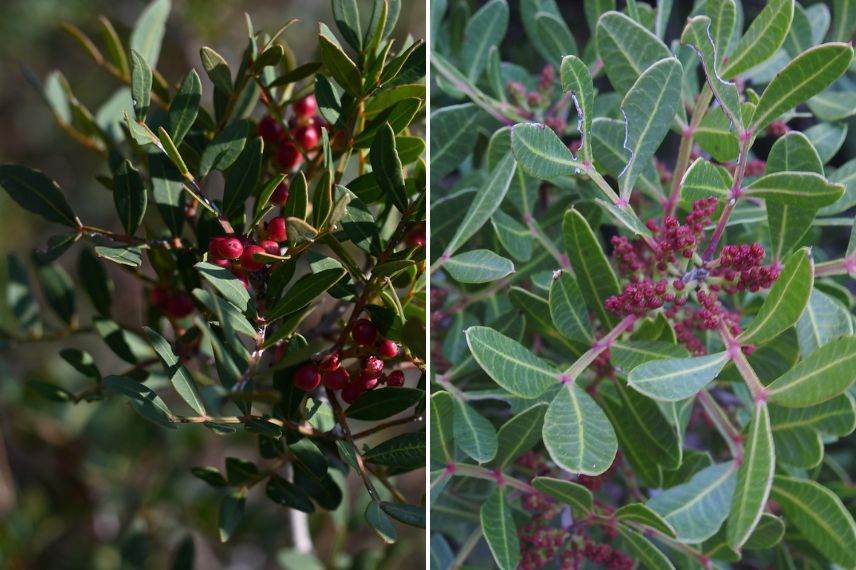
Highly fruitful, its bright red fruit is always very decorative against its evergreen foliage.
The Laurustinus – Viburnum tinus 'Eve Price'
The Viburnum tinus ‘Eve Price’ is a cultivar of laurel tin that stands out from the typical species due to its more colourful pink flowering and its naturally very dense foliage. It is a very robust evergreen bush that forms its small umbels from autumn, in the shape of decorative pink flower buds. The flowers bloom more or less early in winter depending on the regions and the climate, and are followed by cobalt blue fruits that later turn black, attracting birds.
This is a plant that delights the gardener all year round and is appreciated by all small wildlife. As it tolerates pruning very well, the laurel tin is perfect for creating a privacy or windbreak hedge, whether free-form or trimmed. Finally, it adapts to all exposures, even in shade, and to all soils, even very calcareous and dry in summer.

The laurel tin ‘Eve Price’ brightens the undergrowth with its fresh green foliage. Its flowering is sumptuous and so generous.
Narrow-leaved Phillyrea – Phillyrea angustifolia
Cousin of the olive, the Phillyrea angustifolia naturally forms a small tree with a fairly short single trunk, whose crown is spreading and has long, narrow leaves of bright green. Small fragrant cream flowers appear in axillary clusters in May and June. Watering is not necessary. It produces small bluish fruits that are favoured by birds. In the wild, it rarely exceeds 3 m in height with a spread of 2 m. Its growth is quite slow in poor soil, somewhat faster in deep, more fertile soil.
It bears young bronze shoots that develop into narrow, elongated leaves, leathery, measuring 3 to 5 cm long and 1 cm wide, with a fairly strong ash-green colour on the upper side, paler and velvety underneath. They are slightly glossy.
The flowering period from March to May is rather discreet, with a cream-white hue that is slightly greenish. Gathered in small clusters at the axils of the leaves, they are lightly scented and melliferous. Flowering is followed by the formation of fruits known as drupes containing a stone, which are a delight for birds. They turn a bluish-black colour at maturity in autumn.
This small tree can live for many years in poor, dry soil. Easy to cultivate, the mock privet only fears very cold winters, especially when young. A well-established specimen, aged 4 or 5 years, will be able to withstand brief frosts of around -12 to -15°C. As it is not afraid of sea spray, it can be adopted without reservation by the seaside to form a border or hedge even in shade.

The fine, dense light grey foliage of the mock privet makes it an obvious choice for a light, hassle-free hedge. Its generous fragrant cream-white flowering is followed by bluish berries.
The Buckthorn or Variegated Alaternus - Rhamnus alaternus argenteovariegata
Yet another species familiar to the Provençals, the Rhamnus alaternus Argenteovariegata is the variegated white-leaved form of the buckthorn. It is one of the prettiest bushes for dry gardens in shaded areas. Its spring flowering is melliferous, discreet, yet fragrant, followed on female plants by lovely red berries that turn black at ripeness, delighting birds in autumn. It is suitable for all difficult areas to landscape, such as undergrowth and coastal gardens, as it withstands sea spray.
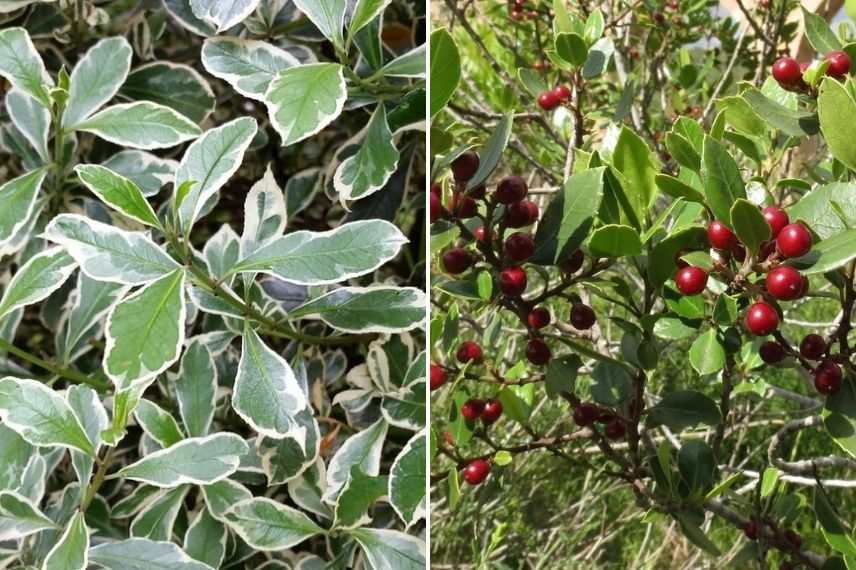
Its light green foliage variegated with white tolerates all exposures, even very sunny ones. Its small reddish fruits later turn black.
Firethorn - Pyracantha coccinea 'Teton'
The Pyracantha coccinea ‘Teton’ is a variety of firethorn that stands out for its denser, bushier and more upright habit than that of the usual varieties. Resistant to fire blight and canker, it is equally floriferous and fruit-bearing, covering itself with white, melliferous flowers followed by lovely berries ranging from golden orange to yellow-orange.
Whether grown as a hedge or trained against a wall, the Pyracantha coccinea ‘Teton’ is one of the most important colourful shrubs in a dry soil garden. This shrub is incredibly robust and one of the easiest to grow, even in poor soils.
Its multiple advantages truly deserve to be integrated into the garden decor beyond a simple defensive hedge, thanks to its long thorns.
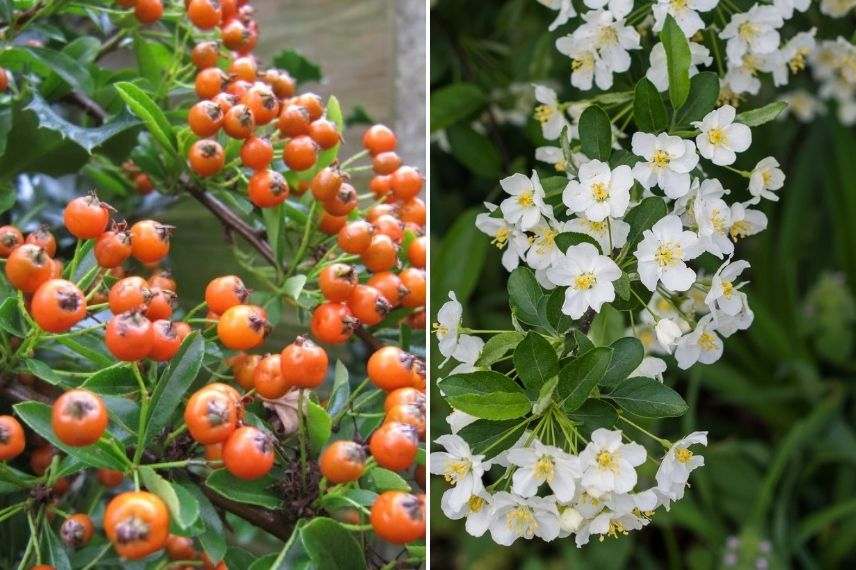
Easy to grow, the pyracantha ‘Teton’ is a gem in all seasons in the garden with no maintenance required
Oleander - Nerium oleander
Originating from the Mediterranean basin, oleander, is a moderately hardy flowering bush (occasionally down to -8 to -10°C) that can reach heights of 5 m. It can even be found naturalised in certain regions such as Corsica or Sardinia, for example.
Their evergreen leaves are whorled in threes or opposite, elongated and leathery, displaying a dark green colour and make oleander a very elegant hedge. Plant your oleander in full sun, in a warm location, sheltered from the north and cold winds, in fertile or enriched, well-drained soil.
In the ground, once well-rooted, it withstands dry periods. In pots, keep the soil fairly moist during the warm season. Ensure good drainage at the bottom of the pots by mixing a bit of garden soil with the potting mix, then add compost on the surface and a layer of mulch.
Choose the ‘Emilie’ Oleander, a beautiful evergreen bush with a bushy habit, featuring a long and abundant flowering of bright light pink from June to October. Hardy and resistant to sea spray, it can, once well established, withstand short frosts of around -8/-10°C. It is the ideal oleander for a seaside hedge.
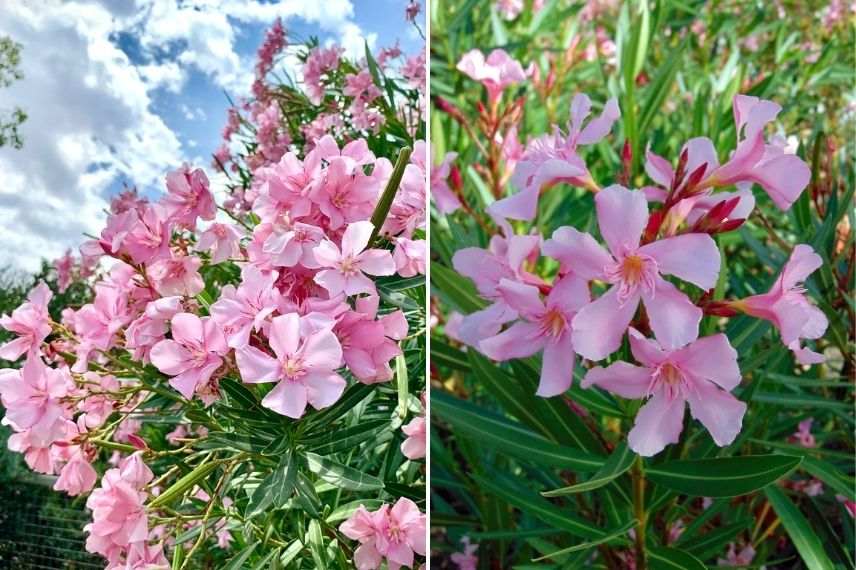
The ‘Emilie’ oleander combines simplicity, ease, and generosity for consistently successful results.
The Oleaster – Eleagnus ebbingei 'Viveleg'
Elaeagnus ebbingei ‘Viveleg’ is an improvement on the ‘Gilt Edge’ variety, boasting exceptional vigour and a darker green foliage beautifully margined with golden yellow to cream. This cultivar exhibits rapid growth, good hardiness, and good resistance to summer drought.
It forms a highly ramified bush with an upright, dense, and compact habit, rarely exceeding 2.5 m in height and 1.5 m in spread. Its foliage, evergreen, consists of tough, entire, lanceolate leaves, dark green in colour edged with bright golden yellow on the top, and a pearlescent almond green with small bronze dots underneath. The young stems are intensely punctate with bronzed brown, just like the juvenile leaves in spring.
The insignificant flowers appear in the axil of the leaves from September to November. They are delightfully fragrant, highly melliferous, and nectariferous. They give way to small elongated oval fruits, coppery in colour at ripeness, containing an oilseed. These fruits, rich in vitamins and antioxidants, are edible for humans and appreciated by birds.
Elaeagnus have a unique root system that has the ability to enrich the soil, somewhat like the roots of legumes.
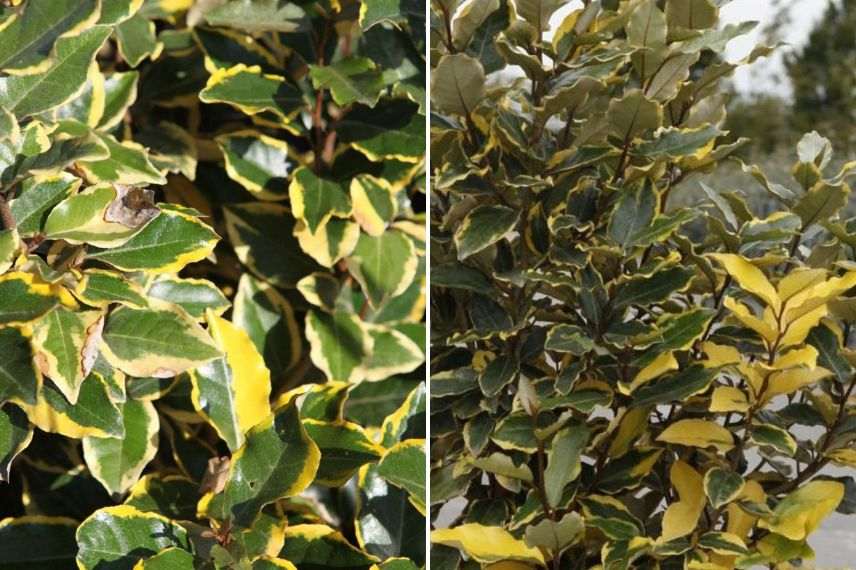
This oleaster Elaeagnus ebbingei ‘Viveleg’ with its bright green foliage margined with golden yellow brightens even the greyest skies as it withstands salt spray and pollution.
Ceanothus azureus 'Concha'
The Ceanothus azureus ‘Concha’ is a stunning variety of evergreen ceanothus. This hardy California lilac is low-maintenance regarding soil type, thriving in both sun and drought, and ages well in poor, light soils, preferring regions with mild winters.
This large bush has a very rounded habit and blooms in spring, offering an abundant and fragrant flowering of particularly dark blue. It forms decorative reddish-purple buds that open into so many navy blue flower clusters that they almost obscure its beautiful glossy dark green foliage, giving an impression of purple.
Eric’s tips: Ceanothus are native to the chaparral in California, a type of scrub vegetation where they thrive with little more than occasional rainfall. Follow his common-sense advice, avoid placing ceanothus in low spots or near irrigation or lawns.
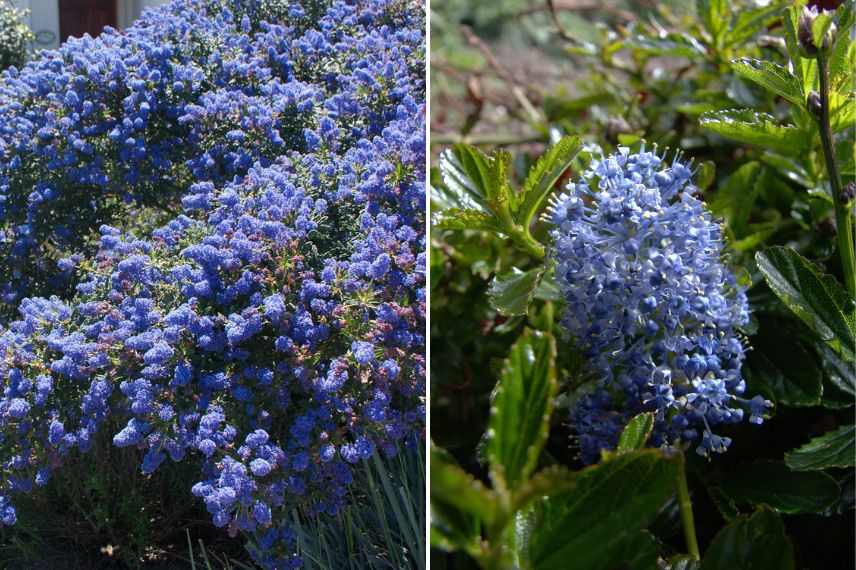
A generous pendulous flowering made of panicles of blue stars for the cultivar ‘Concha’
- Subscribe!
- Contents
































Comments